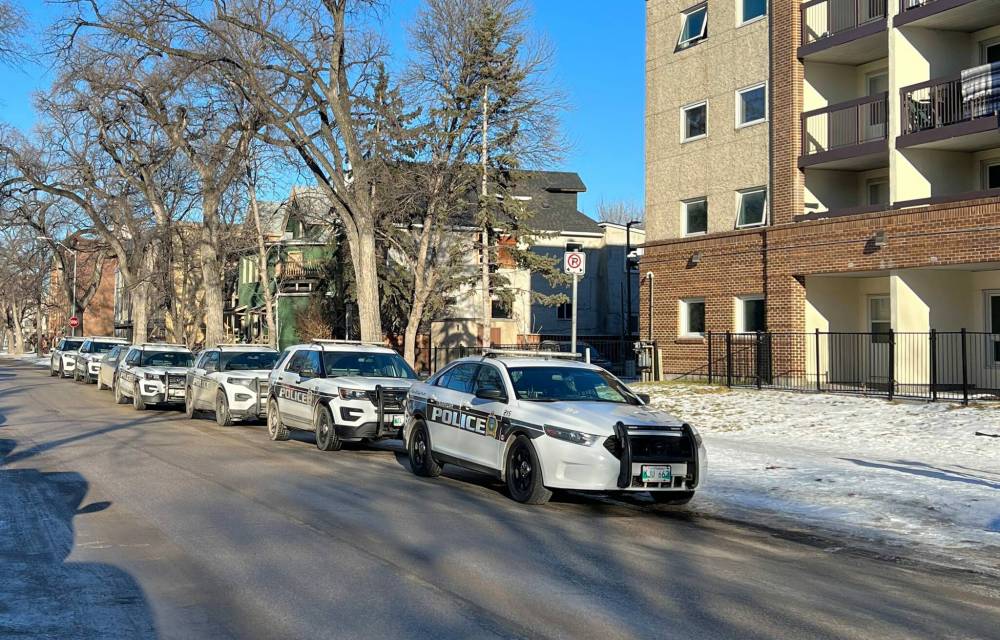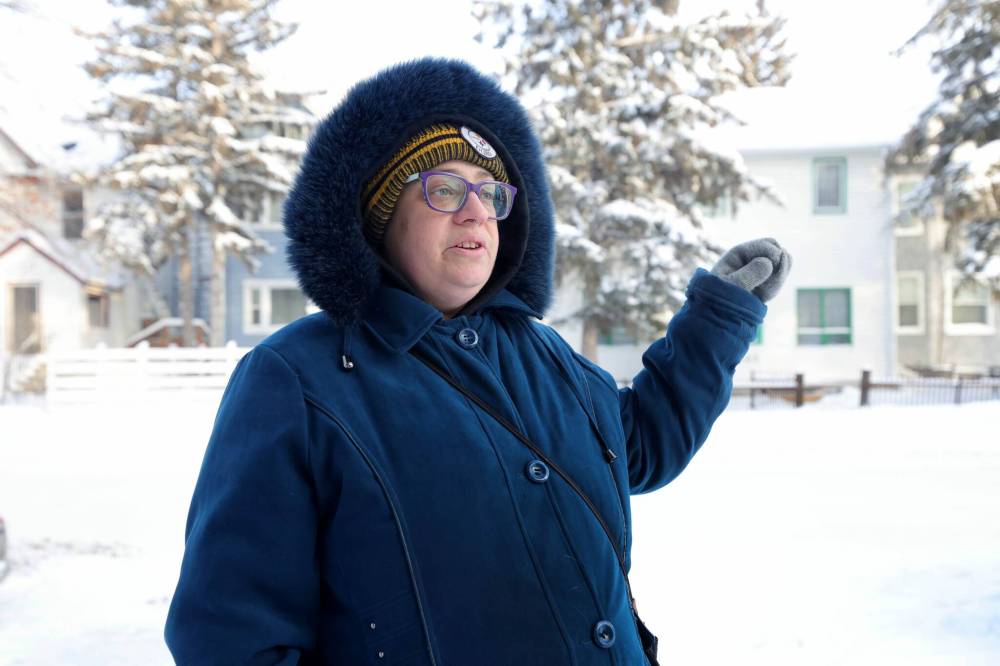Frustration, fear and keeping the faith on Furby Shocking violence on West Broadway street rattles residents, who remain unwilling to give up on crime-addled community
Read this article for free:
or
Already have an account? Log in here »
To continue reading, please subscribe:
Monthly Digital Subscription
$0 for the first 4 weeks*
- Enjoy unlimited reading on winnipegfreepress.com
- Read the E-Edition, our digital replica newspaper
- Access News Break, our award-winning app
- Play interactive puzzles
*No charge for 4 weeks then price increases to the regular rate of $19.00 plus GST every four weeks. Offer available to new and qualified returning subscribers only. Cancel any time.
Monthly Digital Subscription
$4.75/week*
- Enjoy unlimited reading on winnipegfreepress.com
- Read the E-Edition, our digital replica newspaper
- Access News Break, our award-winning app
- Play interactive puzzles
*Billed as $19 plus GST every four weeks. Cancel any time.
To continue reading, please subscribe:
Add Free Press access to your Brandon Sun subscription for only an additional
$1 for the first 4 weeks*
*Your next subscription payment will increase by $1.00 and you will be charged $16.99 plus GST for four weeks. After four weeks, your payment will increase to $23.99 plus GST every four weeks.
Read unlimited articles for free today:
or
Already have an account? Log in here »
Hey there, time traveller!
This article was published 16/01/2024 (698 days ago), so information in it may no longer be current.
The morning after a snowstorm gave Winnipeg its first serious blast of winter last week, Steph Jones could still make out the indent in the snow where her neighbour fell after being shot outside of her Furby Street home the evening before.
Jones is both a tenant and the caretaker at the 142 Furby St. townhouse. As she shovelled fresh snow Friday morning, she described how her neighbour — who went by “Jay” — had been shovelling her own walkway when she was attacked.
“My other neighbour came out, and he was like, ‘That was a gunshot.’ I was like, ‘OK, what do we do?’ So I got my shoes, grabbed my keys, and then we grabbed Jay,” she said.
“We couldn’t get into (her building), so we dragged Jay inside (our) hallway, and then as we were doing it, the other guy had called 911.”
Jones was still shaken by the incident Friday. All they could do until the paramedics arrived, she said, was try to keep their friend warm.
RUTH BONNEVILLE / WINNIPEG FREE PRESS 
“Jay just went white,” Jones said. “Just pure white… we thought Jay was going to die for a second.”
The Winnipeg Police Service has released few details on the shooting, other than the 48-year-old victim had been shot in the upper body, was sent to hospital in unstable condition, and later upgraded to stable. The major crimes unit is still investigating and does not have a suspect.
Jones doesn’t have any idea who shot Jay, and suspects it was entirely random. Jay was lucid after being shot, and described a man cutting into her yard from a nearby housing unit and bumping into her before shooting her and running off.
While Jones said she’d never seen anything like it, the shocking event was just the latest incident in an ever-growing spiral of crime and violence in the neighbourhood she’s long called home.
“Honestly, I’ve been living here for a couple years, and it’s kind of gone downhill a bit and we’re seeing a lot more action,” she said.
“We’re just sick and tired of it, we just don’t want that around here. Who wants that?”
WINNIPEG FREE PRESS FILES
Anyone following trends in Winnipeg crime will know Furby Street — part of “murder’s half acre,” as it was known as early as the 1990s — all too well.
The first homicide of 2024 — a fight in an apartment that ended in the death of 62-year-old man and a 59-year-old charged with second-degree murder on Jan. 5 — happened on the 800 block of Furby.
On Dec. 29, Winnipeg police sent out two incident reports regarding violent incidents in a Manitoba Housing apartment complex at 25 Furby earlier that week. The previous day, an armed man was shot and killed by police after taking three adults and a child hostage. Two days before that incident, the body of a truck driver from B.C. was discovered in the same complex after his abandoned truck was found nearby in the Sherbrook Inn parking lot.
Homicide detectives believe the suspect killed in the hostage situation is linked to the truck driver’s death.
Talk to people living on the street anywhere near where violence has occurred and many of the responses are similar: crime is out of control on Furby, but residents care about the community and have no interest in leaving.
Their explanations for the violence are varied.
One resident and landlord on Furby suggested the nearby Sherbrook Inn could be part of the problem, noting it stocks oversized “king cans” of booze that attract troublemakers from outside the neighbourhood.
“From 2006 till just about before COVID, I would say, things had steadily increased in a positive way here… it’s that bar that attracts people from other neighbourhoods,” said the landlord, who lives on Furby.
“And other people come here for that bar, and then they hang around and a whole bunch of trouble happens.”
Nearby neighbour Jodie Wilkinson said bar patrons were usually quiet in the past, but she started keeping her 12-year-old and nine-year-old kids indoors after dark a few months ago.
RUTH BONNEVILLE / WINNIPEG FREE PRESS 
“I think it’s just the way that the world is now, everything’s just changing, and either you deal with it or you run away,” she said.
“So you might as well just stay and deal with it.”
Furby Street stretches from William Avenue to Cornish Avenue, both north and south of Portage, and much of it runs through the West Broadway neighbourhood.
City census data from 2021 (the most recent available) paints a picture of West Broadway as an outlier to much of the city in some aspects. While neighbourhood residents surveyed were almost exactly as likely to be part of the labour force (64.3 per cent) as the city-wide average (66 per cent), the average annual income for a West Broadway worker was $31,840 — a drop of more than 35 per cent compared to the city average, $50,120. The average household in West Broadway made $45,520 in 2020, less than half what families in Winnipeg did on average ($98,700).
That data informs the housing situation of the neighbourhood. In 2021, West Broadway residents were twice as likely to live in a non-family household (people who share their home with people unrelated to them) and were 2.5 times more likely to rent their home than own, compared to city-wide stats. They were more likely to live in subsidized housing and spend 30 per cent or more of their income on shelter. Census data in 2016, pre-COVID, shows similar trends.
High prevalence of rooming houses
When Winnipeg police Insp. Elton Hall of the guns and gangs unit started his career as a beat cop 24 years ago, he patrolled that same stretch of Furby and the surrounding area. In that time, he said, it has remained a diverse, tight-knit community where residents care for one another.
Because of the recent violence, police have been increasing patrols in the area in an effort to get a handle on the situation that, in some ways, isn’t a lot different than it was when Hall was a beat cop.
Furby and much of the West Broadway area have a high prevalence of rooming houses — multi-tenant homes where separate residents rent rooms but share common spaces, including kitchens and bathrooms. The houses are often left to deteriorate by neglectful owners and become vulnerable to crime, Hall said.
“The landlords never really go to these houses to monitor what’s going on,” he said. “They get the (rent) cheques directly from the government, so when we do talk to landlords or people that own these houses, they really have no idea what’s going on in there. And those rooming houses generally end up turning into drug dens or places where gang members will flock, or you start seeing, maybe, sex trafficking going on. I think that’s a big part of the issue in that area right now.”
Hall said he’d like to see the city collaborate with the WPS and community groups to hammer out stricter bylaws that would keep the owners of these houses and other low-income rentals accountable, but acknowledged it would be a tricky process; unlike bylaws for short-term rentals such Airbnbs, rooming-house tenants are almost exclusively low-income folks with nowhere else to go if a building is shuttered.
“In the 24 years I’ve been doing this, there’s really been no solution on how to deal with this issue.”–Insp. Elton Hall
“It’s tough,” he said. “In the 24 years I’ve been doing this, there’s really been no solution on how to deal with this issue.”
Resource Assistance for Youth is located on Sherbrook Street, a block west of the Manitoba Housing apartment complex at 25 Furby, where the Dec. 29 police shooting occurred and the trucker’s body was found a couple of days earlier. RaY provides a range of supports for people under 30, including case managers for mental-health and addictions struggles, street outreach programs and other supports, including transitional housing for kids in care and for young people experiencing homelessness.
People in the area who use RaY’s services and feel unsafe in their community are most likely to point to their housing situation as the key reason, said Breda Vosters, the non-profit organization’s director of grants and information.
“The options for folks who are looking for low-income housing is you’re either going into a congregate situation where you’re in a several-hundred-unit building that has no security, and you’re with people of a wide array of backgrounds and ages, and anybody is allowed to freely come in and out of those buildings, and you’re in a vulnerable position as a vulnerable person who’s living in a unit around a bunch of strangers.” she said.
“And then your other option is the private market, which, if you’re trying to find something affordable, you’re extremely limited to, largely, rooming houses.”
“It’s an area of concentrated poverty, but it’s right next to a row of things that have been highly invested in over the past few years.”–Breda Vosters
Not far from RaY, Vosters points out new condos going up on Sherbrook Street, while rundown housing is steps away on Furby.
“It’s an area of concentrated poverty, but it’s right next to a row of things that have been highly invested in over the past few years,” she said. “We’ve seen a lot of catering to the higher-income people of this neighbourhood, and less so the lower-income folks.”
The West Broadway Community Organization is a non-profit that manages a string of networks and programs in the neighbourhood.
Three times a week, 10 or so volunteers check on some of the area’s most vulnerable residents and distribute basic supplies and food. The group started last fall after input from community members and WBCO leadership who were worried about their neighbours, executive director Kelly Frazer said.
“I think most of our committee members are very compassionate, and they don’t like to see people in need,” she said. “They’re very happy to see the program running.”
The WBCO also offers “safety auditing” for people feeling unsafe in poorly maintained buildings or witnessing illegal activity, which connects them to resources and neighbours experiencing similar problems. The organization even helps residents put together block parties, as a way to encourage active participation in the community.
“I’d say, in general, West Broadway residents, they are very passionate about living here. They appreciate all the advantages of living in a centrally-located neighborhood with access to great active transportation routes,” Frazer said.
“And they definitely take things in stride if there are incidents in the neighbourhood.”
malak.abas@freepress.mb.ca

Malak Abas is a city reporter at the Free Press. Born and raised in Winnipeg’s North End, she led the campus paper at the University of Manitoba before joining the Free Press in 2020. Read more about Malak.
Every piece of reporting Malak produces is reviewed by an editing team before it is posted online or published in print — part of the Free Press‘s tradition, since 1872, of producing reliable independent journalism. Read more about Free Press’s history and mandate, and learn how our newsroom operates.
Our newsroom depends on a growing audience of readers to power our journalism. If you are not a paid reader, please consider becoming a subscriber.
Our newsroom depends on its audience of readers to power our journalism. Thank you for your support.











